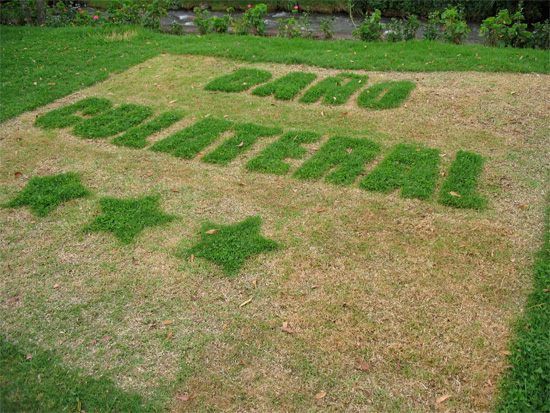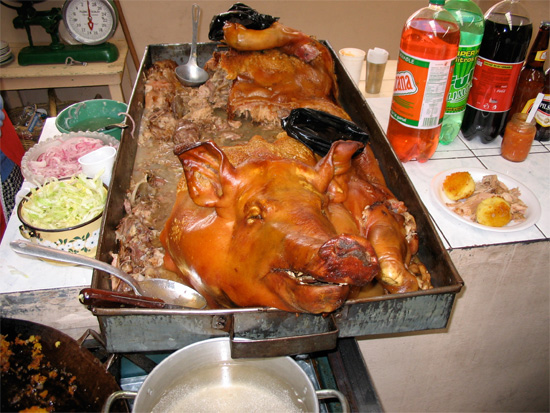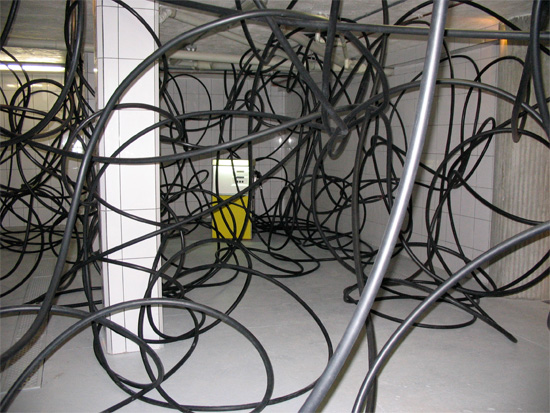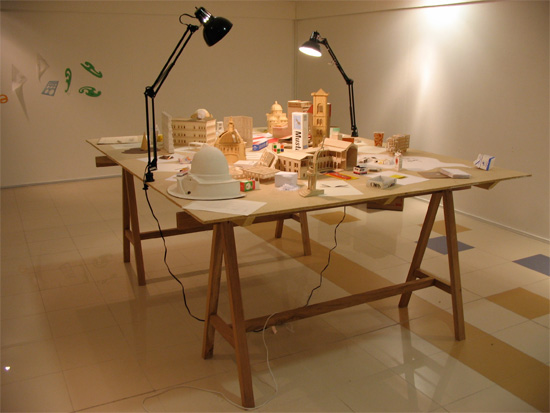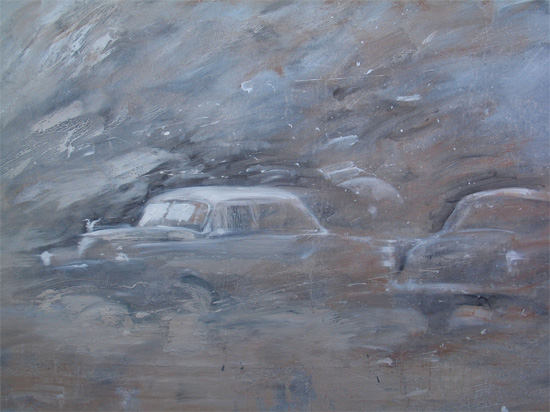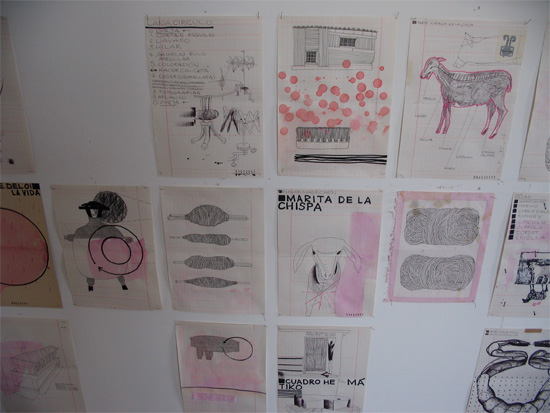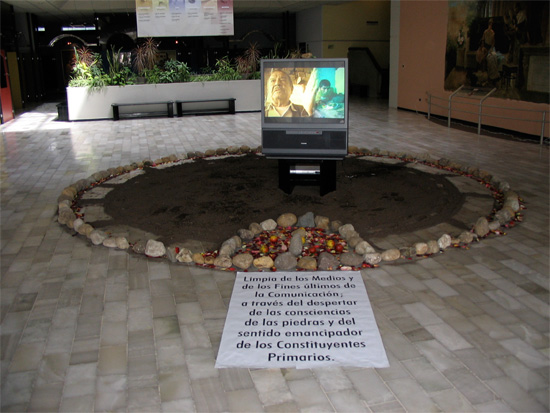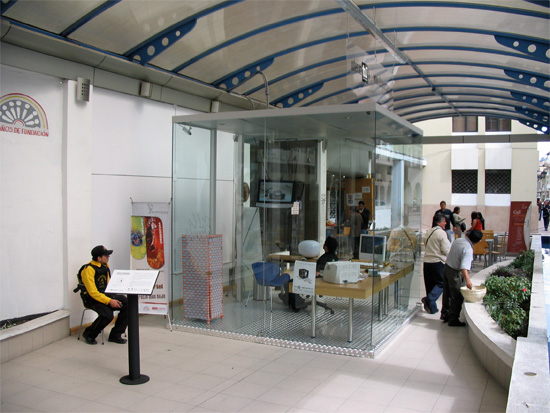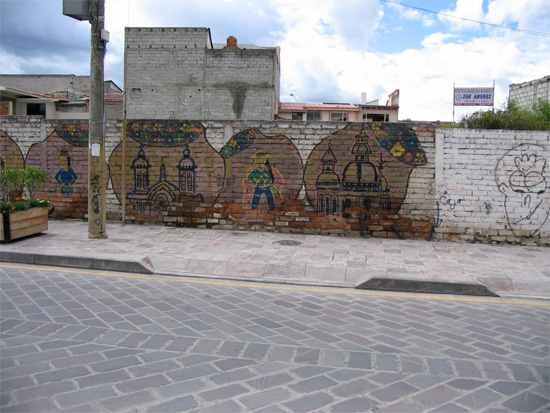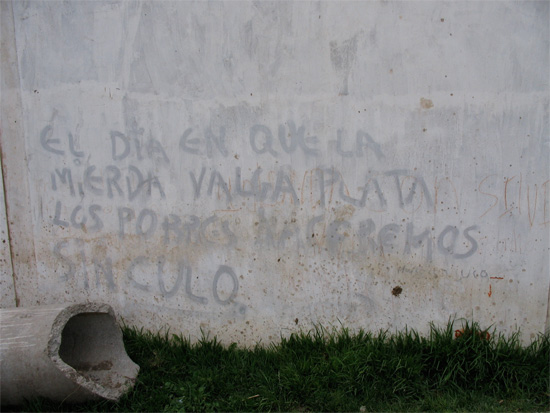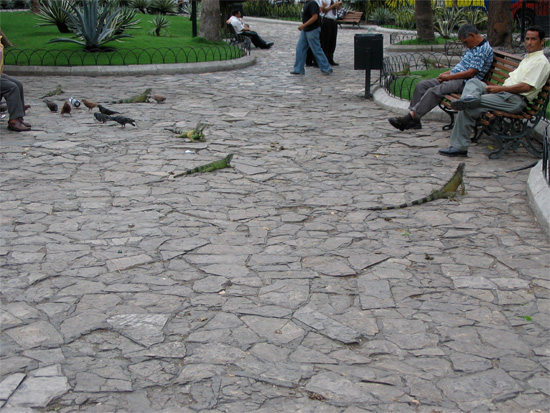
The Knick and the KnackIf our references seem obscure to you, imagine what our boricua friends must think. All we’re really trying to do is wrap the Cuenca thing up and get on to cosas más frescas. Not that we couldn’t dwell gleefully ad infinitum on the perversely self-defeating ways of the biennial—or, to be fair, the quaint high-handedness of the city of Cuenca itself—but we would certainly wear out our welcome for good with the few readers who have hung on for these many months, with their grim forebearance, teeth-sucking, and clucking noises. It’s time to say goodbye to the cows, the pigs, and those sweet, mostly young neo-nomads who have so quickly acclimated to the duties and highly dubious pleasures of the contemporary artworld’s global forced march. What are the verdicts, Meister Slim, Herr Knucklehead, my Chunky Monkey? Overall, it is difficult for us to judge, of course, since this is our first-ever biennial. Surely the most telling sign of the heft of the IX Bienal Internacional de Cuenca, its sterling word- of-mouth to the contrary, is the fact that Rotund World appeared to be the one and only representative of the international press in attendance, at least in the biennial’s early stages and to our admittedly limited knowledge. Does that not boggle the mind? Please don’t tell us there were others in town during our sojourn. The fulsome attentions of the communications department and frank interchanges with the head curator made us feel for a moment like archdukes or possibly even washed-up pop singers out for a final celebrity spin before the sad decline into self-parody and coverdom, and how we treasure the memory.
The twin blows to the biennial’s prestige—the outright censorship of Santiago Reyes’s Sin Título (Eric et moi dormant), a billboard-size banner depicting two young men abed, well covered and peacefully snoozing, and the sudden removal by the city of a mural which artist Mariano Molina had nearly completed (both of which we show toward the bottom of this page)—did not add a whole lot to Cuenca’s luster as a center of cosmopolitan thinking. Although no one has it brought it up, philistine combustion in the face of artistic activity is nothing new for Cuenca. According to Puerto Rican artist Victor Vázquez, he faced almost identical hazing at the indelicate hands of city officials during the 1997 biennial, in almost the same spot. Vázquez told our Rotund foreign correspondent that he and a handful of other artists were invited that year to show photography—then a first for an event which had always concerned itself strictly with painting—in the Monasterio de las Conceptas, the same site as the 2007 mural controversy. Three days before the opening, after visits from the archbishop and the regional governor, Vázquez said, the biennial told him to remove one of his two works, a photograph in which—what else?—a naked woman with legs spread figures prominently. Vázquez uses the human body for portrayals of an exceptional range of metaphorical activity, some of it involving nails driven into flesh and copious excretions, but it is always clear—to us, at any rate—that “metaphorical” is the operant term in his work. With their rich sepia tones and unapologetic fleshiness, his works are often disturbing, mostly for their ambiguity, and he can make a plucked, raw chicken on a dinner plate look seductive. In any event, the sight of so much female essence was apparently too much for Cuencan propriety—while his other work, La Ave María, which only features naked breasts and chicken parts, was not—and after much fulminating on both sides, the two parties reached an agreement of absurd proportions whereby the artist hid the more offensive work behind the merely chesty one. In addition, Vázquez was promised an apology from biennial officals in the exhibition catalogue, although, he told us, he does not know to this day if it ever appeared. So, friends, things could be worse, or more grotesque, we’re not sure. But we are fairly certain that in light of censorship and somewhat derriere garde procedures—the biennial jury awarded three prizes, a creamy $20,000 each, but two went to painting and one to everything else—we came away from Ecuador feeling as if we’d lunched on white bread Braunschweiger sandwiches when we were expecting to feast on a whole lechón.
Still, as you know by now we’re Rotund creatures of habit and we never hold back when it comes to what occupies the breezy space between ears, so we’ll just out and out tell you: The pick of the litter. We’ve praised the Puerto Ricans to high heaven, and, as we already said, the estimable jury—we don’t call them that just because they’re our friends—did what they could with what they had. Besides giving painting prizes to a bunch of sculpture and a light show, one of the honorable mentions went to a Cuenca artists collective, La Limpia, for their installation Prolongaciones, a roomful of gas pump hoses surrounding an actual gas pump (shown below, dimensions variable, 2007). Not that Gego didn’t do this sort of thing with considerably more aesthetic punch decades ago, but the times being what they are, and the place, we’re inclined to cut La Limpia a lot of slack and say that we appreciate their tribal spirit, so like Puerto Rico’s own =Desto. A couple of pages back we presented a detail of Mateo López’s prize-winning Narraciones de encuentros casuales (installation with drawings, paper, cardboard, plastic, and modeling clay, dimensions variable, 2005-2006), but we thought we’d give you a chance to step back and see the whole incredible shebang, which also appears below.
Best actual painting in a painting biennial overwhelmingly “other.” Who are we to judge, really? But we very much liked the swarthy, slathery scenes of ghostly Havana streets, plied, as in many an artworld cliché, by decrepit yet still-moving glories of mid- twentieth-century Detroit. Luis E. Camejo brought three hunky works to Cuenca, all titled Sin título, each one oil on canvas, 79" x 119", and made this year. Maybe it’s our long-lost love for those exact replica toy cars the local Chevy dealer used to bestow on us every new model year, which we pushed around in the dirt making the vroom vroom eeeeeeeeeerrrrrt noises and having stock car races with lots of spinning out and rolling over and spectacular head-on crashes. But never mind.
Best dressed sheep in town. Ilka Helmig and Andreas Reichel, artists who live and work in Bonn, Germany, decided it would be amusing to travel halfway around the world, find a sheep, shear it, use the wool for a sweater which would be fashioned by local knitters and dyed with natural colors, and then—of course!—dress the sheep in the sweater for a high tone evening with all the biennial swells. What a hoot! But is it art? That you can judge for yourselves. Helmig created the wall of very nice drawings below, and Reichel spent a great deal of time gathering sheep turds and other effluvia to make necklaces and such-like wearables and seeables. If that’s not art we don’t know what is. You know what they say about not naming the meat you’ll one day have to consume. Well, Helmig and Reichel christened their sheep Marita de la Chispa, so there’s little danger she’ll end up in a stewpot. At least not theirs. Below, Marita frolicks, sort of, in a tasty field of greens, dressed to the nines. The video was made by the artists as part of their project.
Who says conceptual photography can’t be funny? Albano Alfonso is our kind of photographer, a self-deprecating joker who’s out to make a point. His series of twenty-four autoretratos, lining opposite walls of el Museo de los Metales, plays on the notion that Latin American artists—on one side, all the same self-portrait, all obscured by the flash—labor under a rubric that so-called “Western” artists, the true progenitors of Modernism, do not suffer. On the other side, each portrait features the mask of a master—Manet, Gaugin, or, as shown below, our friend Vincent—which gives the work color and detail—the spark of originality—that the likes of Reverón, Torres-García, and Matta supposedly lack. Not such an original idea itself, but likably acerbic. The series is called Autoretratos, from 2007. Each work is something like 9" x 12".
Best attack on mass media. Everyone likes to beat up on televsion, that brutish, shouting, one-eyed box. No one at the Bienal de Cuenca did it quite like the Otavalo-area collective, Cosas Finas, who, under the curatorial direction of María Fernanda Cartagena, conducted limpiezas with the help of a curandera. We stumbled on this installation at the Museo del Banco Central just as we were about to hightail it out of Cuenca at last. The boys did a cool job, and once we saw what they were up to we kind of regreted having had a laugh at their expense.
Our eyelash-deep prize. Could anything have possibly been more pointless than Sara Roitman’s big glass cube called Topo Urbano Lab? The cube, outside a café in greater downtown Cuenca, was supposed to be home to a corps of ten artists, each spending six to twenty-four hours in front of the computer—or snoozing underneath it—creating original projects for the biennial. The white thingie in the center of the image sums up the project perfectly: a techie-looking object that’s just a lamp.
Best graffiti in Cuenca. In fact it was about the only graffiti we saw. We were about to say that graffiti culture in the Andes needs some work when we came across the lines below in Cañar.
If you really want to know, it says, “The day shit is worth something, the poor will be born without assholes.” Friendliest natives. The biennial’s Tania Lazo Yakimtseva was absolutely heroic in providing us with images and information, doing not only the job of “museologist,” for which she was hired, but communications and public relations specialist as well. We are very grateful. Our pals Michael Jenkins and Judy Blankenship gave us shelter in Cañar in their superb new digs—many of our most unbelievably pastoral shots were taken from their porch—plus an endless supply oatmeal cookies and cafecitos. Espresso in Cañar? Who would have thought? David Pérez of Guayaquil’s dpm Gallery was ever a hale-fellow-well-met, and even after more than ten years away, artist Pablo Cardoso and poet-critic-Cuenca princeling Cristóbal Zapata treated us like home-coming kin, which is to say very kindly. Alexandra Kennedy and Eduardo Vega were likewise gracious. It was an ineffable pleasure—however brief—seeing Jorge Dávila again. It almost hurts to be a critic sometimes. Best reptiles in an Ecuadorian city park. We spent an extra day in the coastal city of Guayaquil on our way home just to get a photograph of the iguanas that rule downtown’s Parque Seminario like wattle-necked lords. It wasn’t anything like Cuenca.
That concludes our coverage of the Cuenca Biennial, and are we glad we got that out of our system. Perhaps you are too, and only too eager to get back to Puerto Rico, with its palmy breezes, its Calle 13, its maddening Ay bendito ways. Until that time we suggest you satisfy yourself with yesterday’s hash, by which we mean the archives accessible below. |

